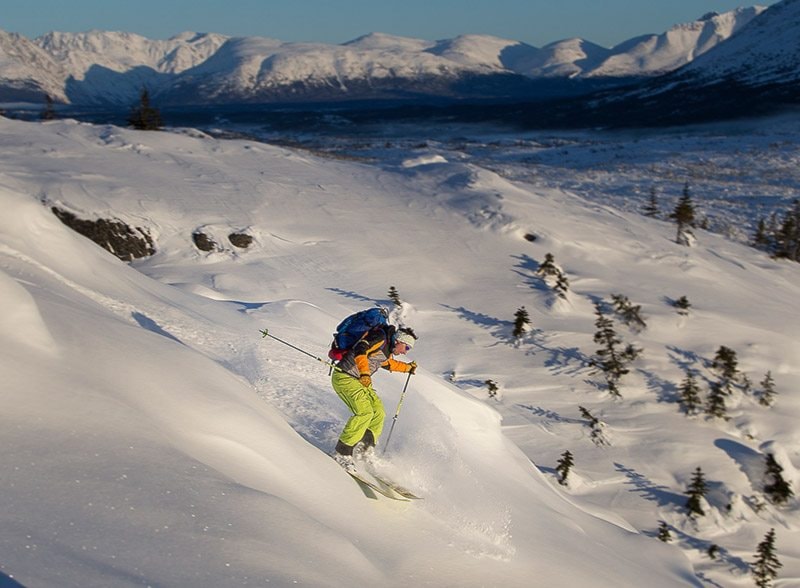Claude Vallier was born in the mountains. He began skiing the French Alps when he was a year and a half old, and he’s been drawn to the slopes — in Europe and North America — ever since.
When he moved to the Yukon nine years ago, he couldn’t find much information about backcountry ski routes. So he went out and found them for himself. Nearly a decade later, there are probably few with a more intimate knowledge of backcountry skiing in the mountains south and west of Whitehorse.
So it makes sense, perhaps, that Vallier should be the one to write the territory’s first backcountry ski guides.
In 2011, he published a guide to the White Pass, the mountain range between Carcross and Skagway, Alaska.
And last month, he released the English version of his guide to the Haines Pass, for the region south of Haines Junction.
Vallier said his friends and other ski groups used to ask him for advice about routes. He’d give them ideas, show them pictures of the places he’d skied and tell them how to get there. Then his friends suggested he try writing a guide.
“It was kind of a personal challenge,” he said.
The Haines Pass guide describes 60 routes, divided into 10 regions, from the Klehini River near the U.S. border north to the slopes around Kelsall Lake. Many of the routes are concentrated around the Three Guardsmen mountain and the Nadahini area further north, including the Nadahini glacier and the Two Sisters peak.
All the route descriptions include ratings for difficulty and avalanche exposure, as well as Vallier’s own photos. He identifies hazards, including glaciers — he said he’s encountered people skiing on glaciers now and then who don’t seem to know about the danger of crevasses.
Vallier has skied each route in his book at least once. It took him three years to put it all together.
He said the guide includes routes for every level of backcountry skier. When he’s on his own, he said, he likes to tackle some of the steeper, more technical routes on the Three Guardsmen. But when he’s out with his kids, he prefers to stick to the wide-open slopes around Kelsall Lake, where the avalanche risk is lower.
All of the trips he describes can be done in a single day, though he points out in his introduction that there are many possibilities for multi-day expeditions.
Vallier’s guide also describes how to reach each area on skis from the Haines Highway.
One of his goals was to prove to people that they don’t need anything more than skis to get around in the mountains. The Haines Pass is a sensitive environment, he said, where human impacts can last a long time.
“What I really want to promote is just to say, ‘Okay, you don’t need a snowmobile, you don’t need a helicopter, you just need your skis,’” he said. “You park your car and try to have a really low impact on the environment.”
Vallier was drawn to the slopes of northern Canada in part because of their isolation. In France, he said, backcountry skiing is a very different thing.
“In the Alps, it’s really very busy,” he said. “There are tons of people everywhere, you know, ski resorts everywhere. So it was pretty difficult to find some areas where there was nobody.
“Here it’s exactly the opposite, you know? Sometimes … you’re just in the White Pass or Haines Pass and nobody is there. Just you.”
Still, he’s not interested in keeping the mountains’ secrets to himself. In fact, he believes his books have helped bring more tourists to the Yukon. The guides are for sale in Alaska, and even in some mountain shops in the European Alps.
“The mountains, they were here millions of years ago and they will still be there a million years from now. And everybody has access,” Vallier said. “So you know, there is nothing secret. I didn’t discover anything. It was there before. It has been skied before.”
He’s seen an uptick in the number of backcountry skiers since he moved here nine years ago, and he expects the trend to continue. He doesn’t seem too bothered by it.
“You can miss that, just being by yourself,” he said. “But that’s the way it is, you know? There are more and more people on this planet, and we have to share the space.”
Vallier said he’s more interested in encouraging people to try new routes instead of always heading to the same spots. He hopes that if more people get to see the backcountry up close, they’ll be more likely to care about its conservation.
“When you love something, you respect it and protect it,” he said. “And that’s what I try to make happen.”
As anyone who’s driven the Haines Highway will know, the view from the road is stunning. “But climb a little bit higher,” Vallier’s introduction reads, “your sight expands and you realize how vast the territory really is.”
Vallier’s guides, available in French and English, can be purchased in Whitehorse at Icycle Sport and Mac’s Fireweed Books, or from his website: yukonbackcountryskiing.com.
Contact Maura Forrest at maura.forrest@yukon-news.com
